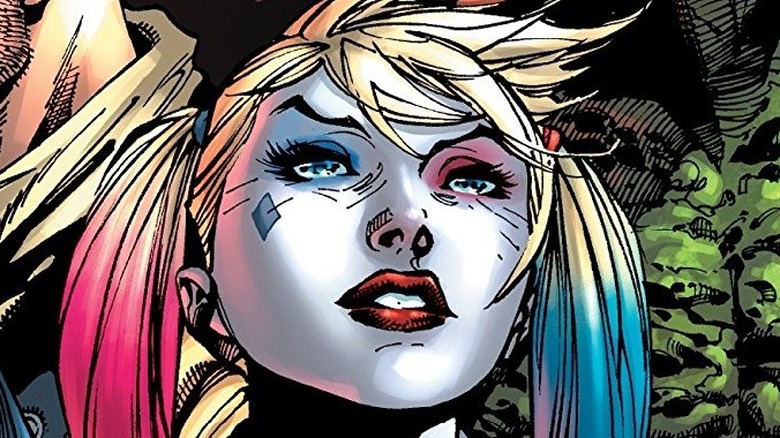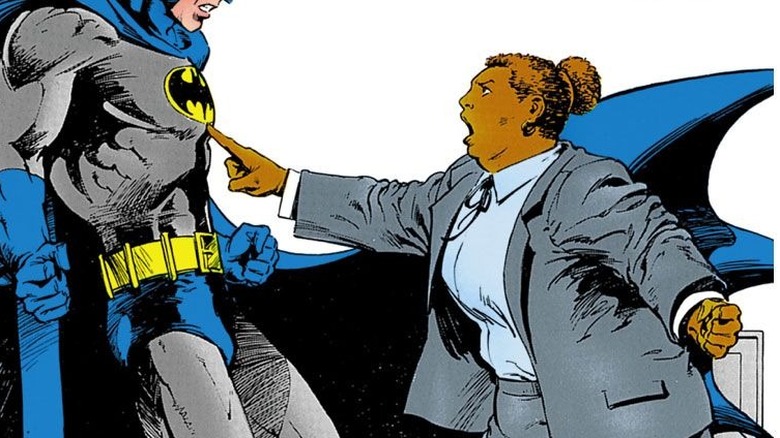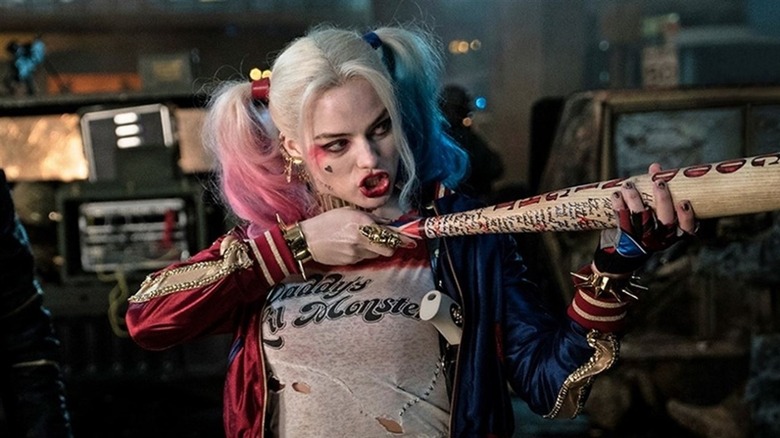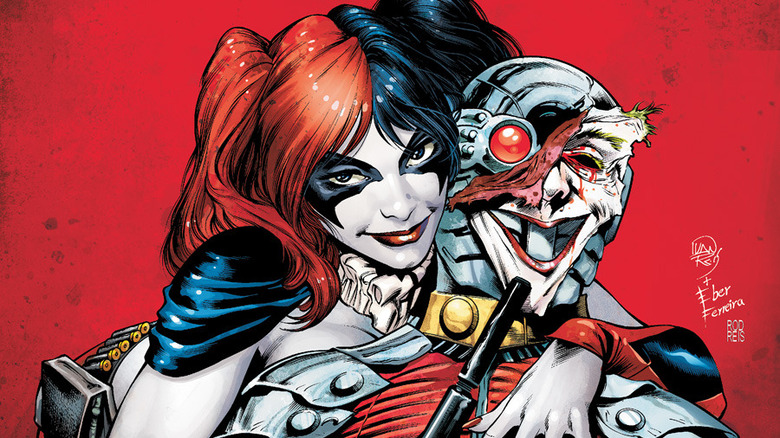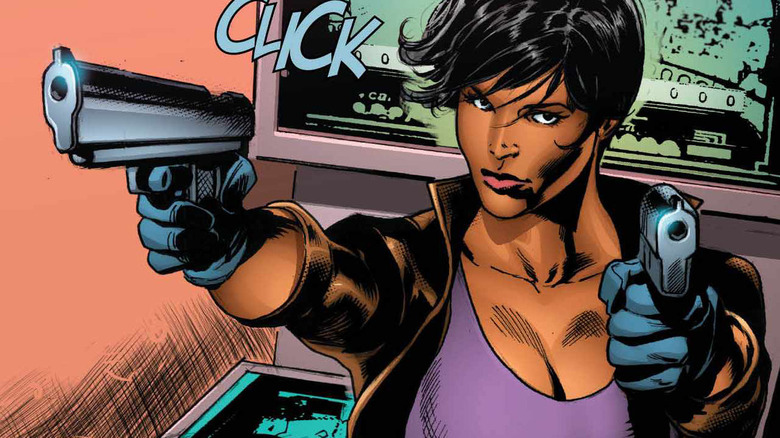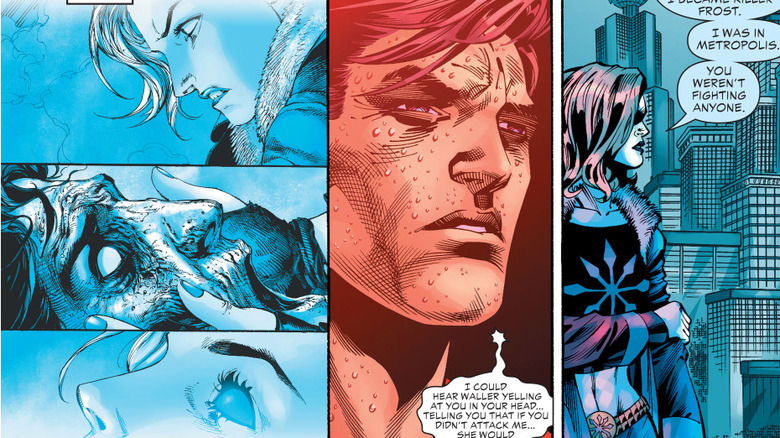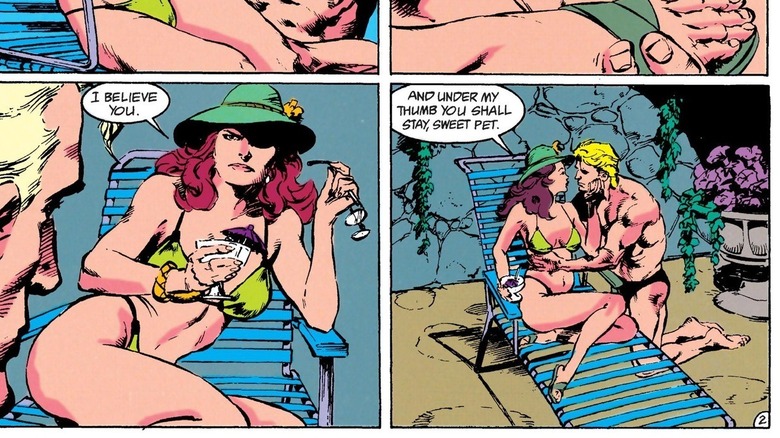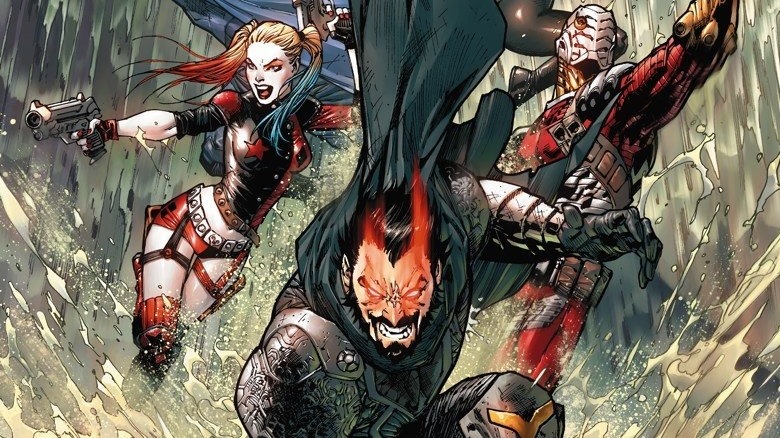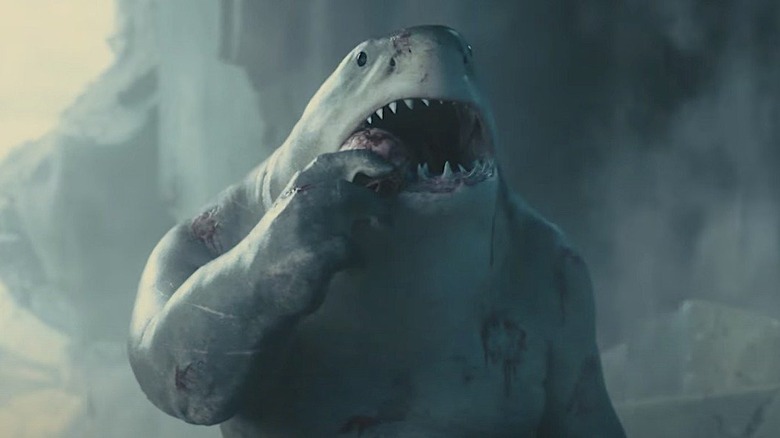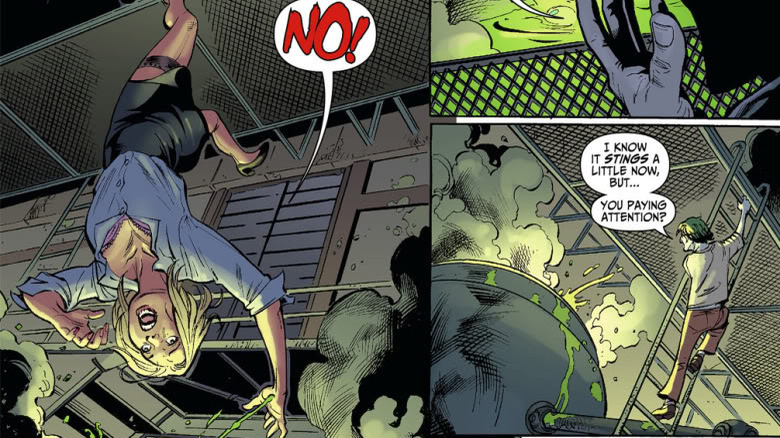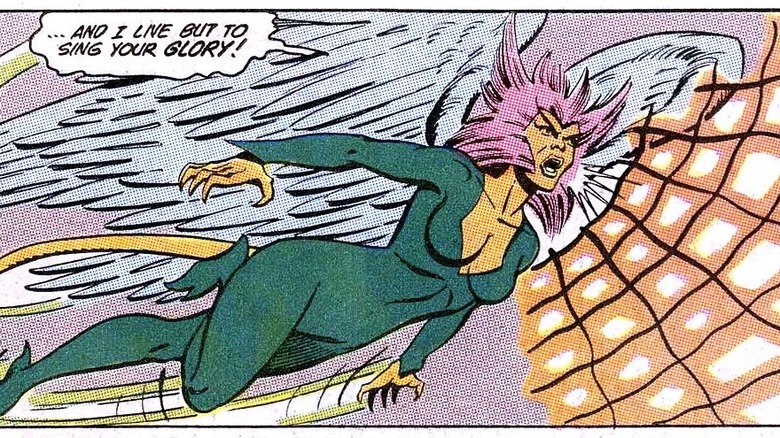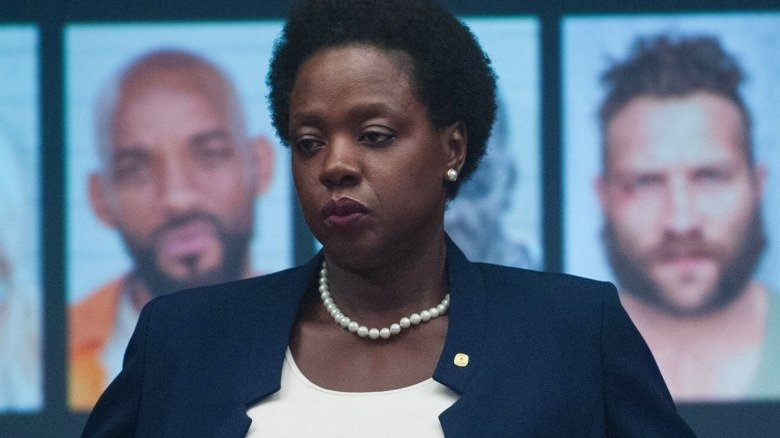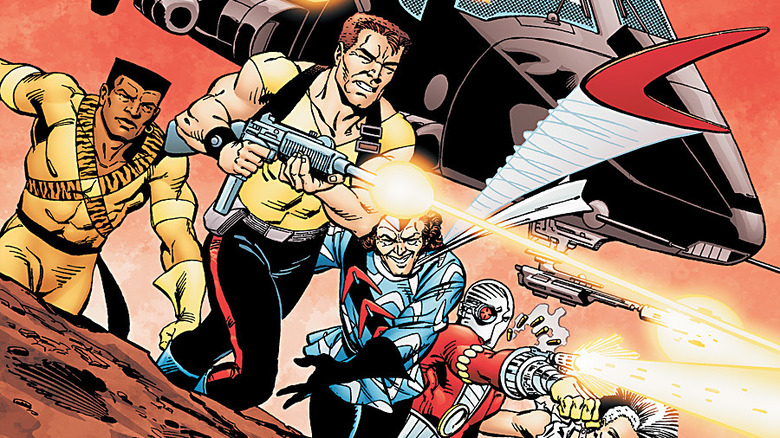The Dark History Of Suicide Squad
The Suicide Squad has a dark history. No surprise there: The team is composed of some of the worst (and best) supervillains from DC Comics. United under the formidable Amanda Waller to be dispatched on dangerous missions, they work for the greater good ... in a manner of speaking. The first version of the Squad debuted in 1959's "The Brave And The Bold" #25. The team was revived in 1987 by writer John Ostrander. Rebranded as Task Force X, Ostrander's Suicide Squad shares strong similarities with the modern team: They're supervillains forced to do good in exchange for reduced prison sentences, overseen by Amanda Waller.
Task Force X has featured many members over the years. DC Comics' 2011 New 52 series sees Harley Quinn join the ranks, alongside other notable members such as Deadshot, King Shark, and the Enchantress. Other DC villains have served on the team over the years, including Deathstroke, Killer Frost, General Zod, Captain Boomerang, and Poison Ivy.
The Suicide Squad has been a part of some of the creepiest and most divisive chapters in the history of DC Comics. Whether they're involved in controversial creative decisions, almost killing Superman, or accidentally eating their teammates, Task Force X keeps things disturbing, bloody, and dangerous. These are the team's darkest moments.
Amanda Waller takes down Rick Flag
Amanda Waller's character is synonymous with the Suicide Squad, thanks to her long tenure as the team's leader. Nicknamed "the Wall" due to her immovable nature, Waller has proved to be one of the fiercest characters in DC Comics history. Whether she's standing up to Batman or putting supervillains in line, Waller is ruthlessly determined, which makes her the only person capable of managing Task Force X.
Waller debuted in 1986's "Legends" #1, where she immediately rebuffs a racist comment from Rick Flag. Flag asks Waller if she's "out of [her] cotton-picking mind" after hearing her plans to build a team of supervillains. Waller replies, "If you ever again call anything about me 'cotton-picking,' mister — I'll stuff those bright, shiny eagles on your shoulders so far up your butt, they'll be able to nest in your skull!" This moment serves to cement Waller as the bulldozing badass that she is, while also highlighting a controversial aspect of the Suicide Squad's history. Waller's debut is a milestone for representation and diversity in the comic book industry nonetheless, and she has gone on to become one of DC's most popular characters.
Harley Quinn gets a controversial costume change
Harley Quinn's traditional costume is well-known, especially to fans of "Batman: The Animated Series." Created by Bruce Timm and Paul Dini, Quinn debuted in the 1992 episode "Joker's Favor" as the henchwoman and love interest of the Clown Prince of Crime. Here, Quinn's trademark look includes a red and black jester suit, reminiscent of a harlequin costume, which covers her from head to toe.
The jester suit stuck with Harley for years. However, the New 52 brought some big changes to the character, including a new costume for her new team. In her 2011 Suicide Squad debut, Harley becomes almost unrecognizable to longtime fans. Gone is the iconic jester suit and hat. Instead, Harley is overtly sexualized, scantily clad in a revealing bustier and hot pants.
Harley's new look has drawn criticism from many fans, who feel that the character has been objectified. This hyper-sexualization has followed her character to the big screen: David Ayer's 2016 movie "Suicide Squad" has also come under fire for Harley's skimpy wardrobe, as well as the numerous shots of the character in provocative positions.
Harley Quinn makes Deadshot wear the Joker's face
A character as chaotic as Harley Quinn is bound to have a dark story. The therapist-turned-supervillain joins Task Force X in 2011's "Suicide Squad" series after being captured by Black Canary and recruited by Amanda Waller. Harley proves to be a wild card throughout her time with the team: Despite her best efforts to get over the Joker, her passion for Mistah J leads to plenty of sticky situations. This includes a grisly confrontation between Harley and her new love interest, Deadshot.
Early in the New 52 reboot, the Joker has his face surgically removed by Dollmaker (yes, really) to prove to Batman that, unlike members of the Bat family, Joker is who he is even without his "mask." The severed face eventually finds its way to Harley Quinn. Struggling with the supposed death of her puddin', Harley lures Deadshot, a.k.a. Floyd Lawton, away from the team, ties him to a chair, and attaches the Joker's face to his. Harley then goes on to have one of the most gruesome therapy sessions ever, speaking to Deadshot as though he's the Joker until he manages to break free. This moment is made worse when readers recall Harley and Deadshot's steamy sex scene earlier in the comic. Yikes.
Amanda Waller gets a makeover nobody demanded
Amanda Waller's debut in DC Comics was a big deal. During a time when female characters tended to be young, white and thin, creator John Ostrander wanted something different for Waller. In an interview with Vulture, Ostrander described the creative process behind Waller's origins: "To start off, I wanted someone who is African-American, because at the time there weren't as many African-American characters in comics. And I wanted the character to be female because we didn't have very many female characters, either ... And I thought she should be a little bit older."
This is likely why many fans felt a sense of betrayal when Amanda Waller re-debuted as part of DC's New 52 reboot. Revamped Amanda is still a Black woman, but she's slimmer, muscular, and much younger. With her heavyset stature gone, "the Wall" no longer suits her as a nickname as well as it once did. Alongside Harley Quinn's sexed-up redesign, this new look for Waller stung all the more.
Ostrander criticized Waller's new appearance in a column he penned for Comic Mix entitled "Up Against The Waller." He labeled the changes as "misguided," explaining, "There were and are reasons why she looked the way she did. I wanted her to seem formidable and visually unlike anyone else out there. Making her young and svelte and sexy loses that." Many fans agree.
Killer Frost drains Superman's life force
The Suicide Squad has a dark history on and off the page, with characters and creators attracting no small amount of controversy over the years. One of the darkest moments in the team's history involves Superman nearly meeting his doom at the hands of Killer Frost.
2017's "Justice League vs. Suicide Squad" series sees the Justice League go after Amanda Waller and Task Force X after discovering the Squad's existence. True to form, Waller and the team don't back down without a fight. In the second issue, the Enchantress and Killer Frost take down Superman in an impressive show of strength. Enchantress weakens the Kryptonian with her magic, and Killer Frost, acting on Amanda Waller's orders, uses her powers to absorb Superman's life force. The hero is quickly weakened, withering to a corpse-like shell of his former self while Killer Frost gets an epic boost in power. Superman's near-death experience serves to remind readers of the deadly difference between the two teams, summarized best by Deadshot: "The Justice League doesn't kill ... but we do!"
Poison Ivy uses mind control to enslave Count Vertigo
Poison Ivy's powers make her a valuable addition to the Suicide Squad when she allies herself with the team. A gifted botanist, Ivy can secrete incapacitating toxins from her skin, survive contact with all manner of poisons, control plant life with her mind, and, perhaps most intimidatingly, puppeteer others through mind-altering pheromones. If Ivy wants you to do her bidding, she'll get her way.
Her list of victims includes Count Vertigo, who joined the Suicide Squad in 1989. After she is sent by Waller to break Vertigo free from the control of Vlatavian rebels, Ivy takes the opportunity to place him under her own command. She forces him to obey her and remain loyal against his will. The ethical implications of Ivy's mind control are called into question by Waller, who aptly labels Ivy a "slave-holder." Waller eventually manages to break Ivy's mind control and restore Vertigo's free will, though Vertigo understandably nurses a grudge against Ivy going forward.
Zod performs brain surgery on himself
2016's "Suicide Squad" series takes the team to new heights with the addition of a legendary supervillain: General Zod. In this run, Amanda Waller dispatches the team to the Phantom Zone, just in time for Zod to tear his way free from it. The team faces off against the Kryptonian tyrant, but eventually, Waller manages to subdue him with a surgically implanted Kryptonite bomb in his brain. Zod is bent to Waller's will and forced to join the Suicide Squad — for a short while, anyway.
Not one to be subdued, Zod breaks free from Waller's control in a grisly display of willpower. How, you ask? Zod uses his heat vision and a mirror to perform brain surgery on himself. The process is bloody and brutal, but the general doesn't stop until the bomb is removed, tearing through his own skull with his laser eyes to remove the implanted Kryptonite. Zod's self-performed brain surgery highlights the violence that sets the Suicide Squad apart from other comic book teams like the Justice League and the Teen Titans, while shining a spotlight on the risks of employing supervillains.
King Shark eats his teammates
Unsurprisingly, the Suicide Squad doesn't always get along. In 2012's "Suicide Squad" #5, Amanda Waller sends team member Yo-Yo to retrieve King Shark to help quell a prison riot at Belle Reve. The plan goes awry, however, as King Shark unceremoniously sinks his teeth into Yo-Yo and devours him whole. This isn't the first time King Shark has feasted on people, though it goes to show that not even fellow Squad members are safe from becoming the humanoid half-god's next meal.
To make matters darker, it is later revealed that Yo-Yo survives being eaten by King Shark. The elasticated anti-hero returns after climbing out of King Shark's unconscious mouth, to the astonishment of El Diablo. He reveals that he's spent months inside King Shark, being slowly digested by his stomach acid. Yo-Yo confronts Amanda Waller, who reveals that this was part of her plan all along: She wanted to test the boundaries of his powers. But Yo-Yo's return is short-lived. In 2013's "Suicide Squad" #18, he sacrifices himself to stop his evil sister, Red Orchid, by wrapping around her neck and allowing Deadshot to kill them both by firing at the bomb in his neck.
A different origin story for Harley Quinn
Harley Quinn's origin story is an iconic part of her history. Dr. Harleen Quinzel, a psychiatrist at Arkham Asylum, is assigned to treat the Joker ... only to fall madly in love with the supervillain instead. Blind to his abuse, Harley breaks her puddin' out of Arkham and soon relinquishes her former identity. Donning her trademark jester suit, hat, and stage make-up, she reunites with Mistah J as her new self: Harley Quinn.
The 2011 "Suicide Squad" series tweaks Harley's origin considerably. Instead of being naïve and morally dubious, Harleen Quinzel is a more stern authority here, who sees through the Joker's attempts at manipulation. Eventually, however, she still falls in love with him and breaks him out of Arkham. The Joker then throws her in a vat of acid at a chemical plant, mimicking his own (possible) origin story. Harley emerges from the vat with bleached white skin, red and black hair, and a whole new attitude.
Many fans criticized these changes, arguing that her new origin removes the character's agency. Instead of choosing to become Harley Quinn, Harleen's transformation is controlled by the Joker, with their relationship becoming even darker.
The second Shrike's death
Plenty of Task Force X members have perished throughout the years. The death of Shrike, however, is one of the darkest and most tragic demises the Suicide Squad has ever seen . The second character to use this name, Shrike first appears in 1985's "Justice League Of America" #235. Child-like and naïve, the mentally malleable Shrike often finds herself on the receiving end of manipulation. She also reveals to the Suicide Squad that she was assaulted during her childhood, leading to a lifetime of mental health issues.
Writer John Ostrander gives her character new depth and a tragic end in 1989's "Suicide Squad" #25. While trying to rescue a captive nun, Shrike is shot multiple times and left for dead. Wounded and dying, Shrike says her final words: "I'm a-comin', Jesus." The moment is even more of a tearjerker when one considers the sad life this character has led. We're not crying, you're crying.
Amanda Waller takes manipulation to new lows
Will Smith's Deadshot is right to call Amanda Waller a "mean lady" in "Suicide Squad." Throughout her history, the leader of Task Force X has made morally dubious decisions while working for the greater good, most notably forming the Squad in the first place. Waller is a master of manipulation, evidenced best by her shrewd handling of the dictator Guedhe in 1992's "Suicide Squad" #66.
Faced with Guedhe, a.k.a. Edwardo Guzman, the tyrannical leader of a remote island, Waller uses her wits to save her life and stop the bad guy. Waller tells Guedhe that she is imbued with a "metagene" that gives her a lethal touch — and she uses her "power" on Guedhe's wife, Maria, to prove it. Unaware that Waller actually gave Maria some of Poison Ivy's toxins to render her unconscious, Guedhe succumbs to despair and follows her to her believed grave. That's right: Like Padme Amidala in "Star Wars," Guedhe seemingly loses the will to live after supposedly losing a loved one. A boss move on Waller's part, perhaps, but also a shocking look at the extremes she's prepared to go to.
The original Suicide Squad
The Suicide Squad is morally ambiguous from the start. As revealed in 1964's "Star-Spangled War Stories" #116, the team is originally assembled by the government from soldiers convicted of felonies, who are deemed "expendable." This early iteration of the team, nicknamed the Suicide Squadron, is sent on high-risk missions with low chances of survival, such as fighting on Dinosaur Island. The team manages better under the leadership of Rick Flag Sr., whose son leads the second version of the team, as well as the modern roster most well-known to fans.
Over the years, the Suicide Squad has featured a diverse and deadly mix of supervillains. But there's something uniquely sad about this first line-up of warriors: Without the drama and theatricality of characters like King Shark and Harley Quinn, the reality of their hopelessness is all the more apparent. Some characters find redemption in Task Force X, while others find death. But no one really wants to be there in the first place.
